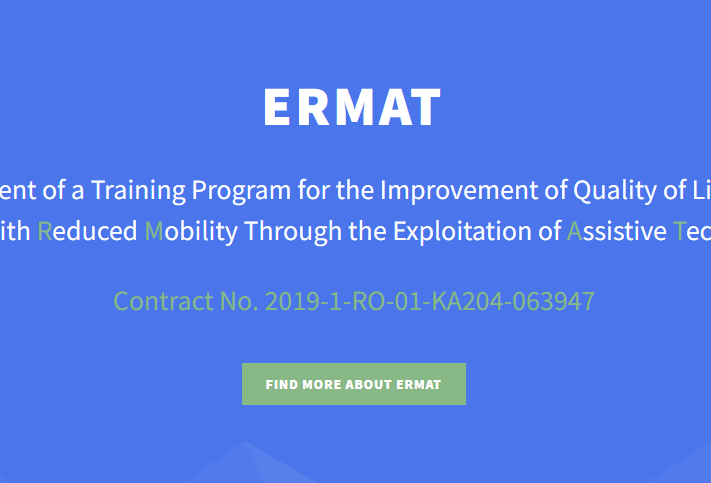
| Short descriptor of good practice |
| The ERMAT project was launched with the main objective of increasing the competences (attitudes, knowledge, skills) of Elder Persons with Reduced Mobility (EPRM), Informal Caregivers and Professionals on the application of Assistive Technologies for improving their Quality of Life (QoL). Mobility is an important predictor of Quality of Life (QoL) among and a measure of successful aging. ATs offer products, resources, methods, strategies, practices and services that support Persons with Reduced Mobility in attaining autonomy, independence, QoL and social inclusion. |
| Type of setting where good practice is delivered |
| NGO, Adult Education, Private setting, Social enterprise, Community health center, Educational centre – Vocational Training (tertiary level) |
| Time Frame for delivery of good practice |
| Individual lessons, focus groups, group training. Time frame is for delivery depends on several factors. |
| Type of learner the best practice is supporting |
| Elder Persons with Reduced Mobility (EPRM), Informal Caregivers and professionals on the application of Assistive Technologies for improving their QoL. |
| Resources used as part of good practice |
| https://erasmus-plus.ec.europa.eu/projects/search/details/2019-1-RO01-KA204-063947 Final report (All countries) https://ec.europa.eu/programmes/erasmus-plus/project-result-content/359f392c-2ba5-420e-ae64-4881cdcd9231/IO4-A5_-_Final_ERMAT_Report_after_validation_sessions_-_submitted.pdf Platform https://www.citst.ro/projects/ermat/platform/ |
| Aims and objectives of good practice |
| (1) inform about available ATs and their application to the specific needs of EPRM; (2) create awareness and trust for using ATs for improving QoL; (3) promote sense of self care and care supported by ATs; (4) create an e-learning environment to improve digital skills and access for EPRM and supports to properly exploit ATs; (5) adopt a user-centered approach. |
| Evidence as to why this was considered good practice |
| – Co-Created Methodological Guide in 6 languages – Training Materials in 6 languages – Designed Practical Training Activities in 6 languages – Handbook for trainers in 6 languages – E-Training Platform in 6 languages including a manual for the e-training platform usage – Direct involvement of end-users in 3 sessions (127, 117, 130) – Implementation of Multiplier Events in 6 countries (142 stakeholders) – 1 scientific-technical article accepted for publication in the EDULEARN 2022 (International Conference on Education and New Learning Technologies ) proceedings. |
| 3 Key learning Principles that were used in this good practice to support senior learners |
| 1. Practical Skill Development for Professionals 2. Experiential Learning 3. Collaborative Learning |
| Any additional learning that we can take from this good practice example |
| Project was focused on increasing the competences of elder persons with reduced mobility, informal caregivers and professionals on the application of assistive technologies. Through learning platform learners can: – Discuss mobility-related topics you are interested in – Ask questions regarding materials, courses, activities and how to use the platform – Connect with people similar to you and share your experiences – Learn ways in which to lead a healthy and happy life – Instruct yourself to become independent and autonomous – Discover ways in which to properly take care of your needs – Interact through audio-video means with trainers and other participants – Collaborate in Wiki-writing type of documents to share the knowledge you have with other participants |
| Any Additional Information |
| / |
